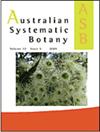多个分子和形态学数据集对神经蜘蛛亚族系统发育重建的影响(禾科:蛇科:蛇科)
IF 1.6
3区 生物学
Q4 EVOLUTIONARY BIOLOGY
引用次数: 5
摘要
摘要Neurachninane的分类学一直不稳定,其成员属包括Ancistrachne、Calyptochloa、Cleistochloa,Dimorphochloa、Neurachne、Paraneurachne和Thyridoidepis,自最初只包括后三个属的范围以来发生了变化。近年来,Neurachninae的系统发育研究主要集中在分子数据上。我们根据7个分子位点(质体标记:matK、ndhF、rbcL、rpl16、rpoC2和trnLF,以及核糖体内部转录间隔区,ITS)的分子数据和104个形态特征的形态学数据,包括新的上苍白的分类信息微形态,分析了新的Neurachninae的系统发育。我们设计了一个影响评估评分(IAS)方案,以帮助选择一棵树来推断Neurachninae的系统发育。结合形态学和分子数据,得到了具有最高IAS值的系统发育。我们的研究结果支持Neurachninae亚系Neurachne muelleri和Dimorphochloa rigida的恢复。我们发现Anistrachne、Cleistochloa和Dimorphochloa不是单系的,而Anistrachine maidenii、Calyptochloa、Cleistachloa和dimorphochlia形成了一个新的类群,即Cleistochomy群,通过具有与生殖二态相关的独特形态而结合在一起。本文章由计算机程序翻译,如有差异,请以英文原文为准。
The impact of multiple molecular and morphological data sets on the phylogenetic reconstruction of subtribe Neurachninae (Poaceae: Panicoideae: Paniceae)
Abstract. The taxonomy of Neurachninane has been unstable, with its member genera consisting of Ancistrachne, Calyptochloa, Cleistochloa, Dimorphochloa, Neurachne, Paraneurachne and Thyridolepis, changing since its original circumscription that comprised only the latter three genera. Recent studies on the phylogeny of Neurachninae have focused primarily on molecular data. We analysed the phylogeny of Neurachninae on the basis of molecular data from seven molecular loci (plastid markers: matK, ndhF, rbcL, rpl16, rpoC2 and trnLF, and ribosomal internal transcribed spacer, ITS) and morphological data from 104 morphological characters, including new taxonomically informative micromorphology of upper paleas. We devised an impact assessment scoring (IAS) protocol to aid selection of a tree for inferring the phylogeny of Neurachninae. Combining morphological and molecular data resulted in a well resolved phylogeny with the highest IAS value. Our findings support reinstatement of subtribe Neurachninae in its original sense, Neurachne muelleri and Dimorphochloa rigida. We show that Ancistrachne, Cleistochloa and Dimorphochloa are not monophyletic and Ancistrachne maidenii, Calyptochloa, Cleistochloa and Dimorphochloa form a new group, the cleistogamy group, united by having unique morphology associated with reproductive dimorphism.
求助全文
通过发布文献求助,成功后即可免费获取论文全文。
去求助
来源期刊

Australian Systematic Botany
生物-进化生物学
CiteScore
3.10
自引率
12.50%
发文量
12
审稿时长
>12 weeks
期刊介绍:
Australian Systematic Botany is an international journal devoted to the systematics, taxonomy, and related aspects of biogeography and evolution of all algae, fungi and plants, including fossils. Descriptive taxonomic papers should normally constitute a comprehensive treatment of a group. Short papers on individual species and nomenclatural papers must contain significant new information of broader interest to be considered. The prestigious L.A.S. Johnson Review Series is published. Other review articles will also be considered. All papers are peer reviewed.
Australian Systematic Botany is published with the endorsement of the Commonwealth Scientific and Industrial Research Organisation (CSIRO) and the Australian Academy of Science.
 求助内容:
求助内容: 应助结果提醒方式:
应助结果提醒方式:


